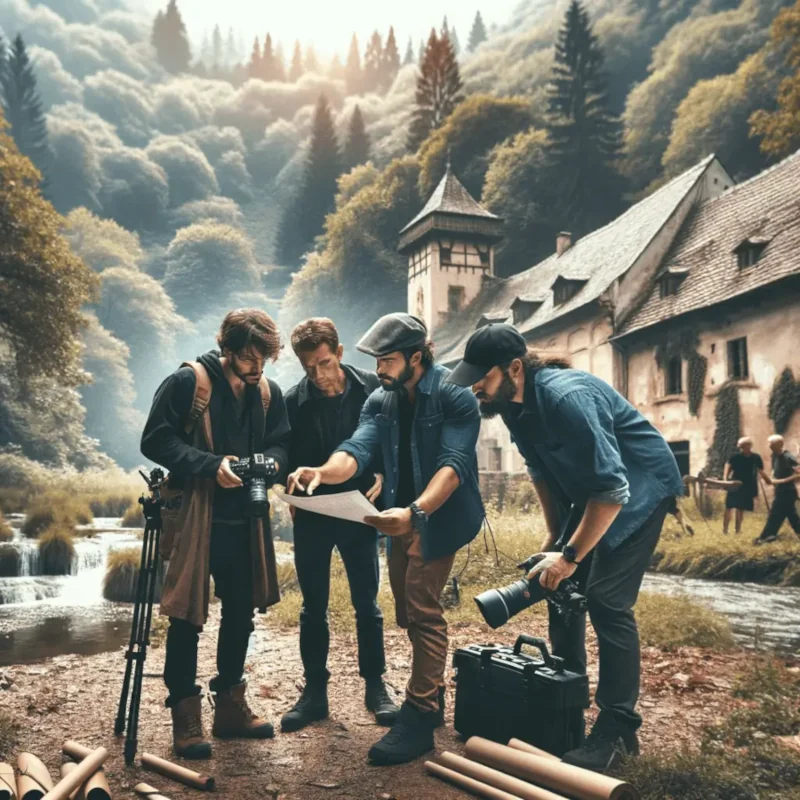Discover the critical first phase in filmmaking: pre-production. This essential stage lays the groundwork for all that follows in creating a movie. It encompasses everything from initial concept development to planning and preparation before the cameras start rolling. In this blog, we’ll explore what pre-production is and walk through its key stages, offering insights into how films are shaped long before they hit the screen. Unlock the secrets of pre-production in filmmaking, where ideas take shape, budgets are set, casts assembled, locations scouted, and schedules crafted for cinematic excellence.
Key Takeaways
- Pre-production is the planning stage before filming.
- It includes concept development, scriptwriting, budgeting, casting, location scouting, and scheduling.
- Collaboration is crucial in scriptwriting and casting.
- Budgeting balances artistic vision with financial realities.
- Location scouting and set design enhance storytelling.
- Scheduling and logistics ensure smooth progress.
What is Pre-production in film?
Pre-production is the planning stage in filmmaking and video production, occurring before filming starts. It involves scriptwriting, storyboarding, casting, scheduling, budgeting, and location scouting, setting the groundwork for production.
What is the importance of pre-production in filmmaking?
Pre-production is essential in filmmaking as it lays the foundation for a successful film. It involves planning, budgeting, casting, location scouting, and scheduling, ensuring that all aspects are in place before shooting begins, ultimately contributing to the quality of the final product.
What is the Pre-Production Process?
The process of pre-production in filmmaking include:
- Concept Development: Generating and refining the film’s idea.
- Scriptwriting: Writing and revising the screenplay.
- Budgeting: Allocating funds for various aspects of production.
- Casting: Selecting actors for characters.
- Location Scouting: Finding suitable places for filming.
- Scheduling: Planning the timeline for shooting.
Concept Development and Scriptwriting
The journey of a film often starts with a simple idea or concept. This nascent stage is where creativity flourishes, as filmmakers brainstorm themes, stories, and characters that will eventually captivate audiences. The concept development phase is crucial as it sets the tone and direction of the entire project. Filmmakers must consider factors such as genre, target audience, and potential market trends to ensure the idea has a strong foundation.

Once the concept is solidified, the next crucial step is scriptwriting. This is where the idea transforms into a tangible script, the backbone of the film. Scriptwriting involves crafting compelling characters, engaging dialogues, and a well-structured narrative. It’s a meticulous process that often involves multiple revisions, as writers strive to refine the story, deepen character arcs, and perfect the pacing.
During scriptwriting, collaboration is key. Writers may work closely with directors, producers, and even actors to ensure that the script aligns with the vision of the film. This phase also often includes developing storyboards, which visually represent sequences of the film, providing a clearer picture of how scenes will unfold.
A good script is a blueprint for success in filmmaking. It guides not only the actors and director but also helps the entire crew understand the vision and direction of the film. Therefore, investing time and effort in developing a strong script is paramount in pre-production..
Budgeting and Financing
Budgeting and financing are the bedrock of any film production. This stage of pre-production involves a meticulous analysis of the costs associated with making the film, from cast and crew salaries to location fees, set construction, and post-production expenses. The goal is to create a detailed budget that balances the artistic vision of the film with the financial realities.

The process starts with producers and financial planners breaking down the script to itemize every potential expense. This detailed budgeting helps in identifying areas where costs can be optimized without compromising the quality of the film. It is also a critical tool for attracting investors and securing financing. Filmmakers often approach studios, independent investors, or use crowdfunding platforms to raise the necessary funds.
Effective budget management is crucial throughout the filmmaking process. It ensures that the production does not run out of funds midway and can adapt to unforeseen expenses. Regular financial reviews and audits are conducted to keep the spending in check.
Casting and Crew Assembly
Casting is a pivotal process in pre-production, as the actors bring the script to life. The casting process involves auditioning a variety of actors to find those best suited for each role. Directors, casting directors, and producers collaborate to select the perfect cast, considering not only talent and suitability for the role but also the chemistry between actors.
Auditions can be extensive, sometimes requiring actors to perform multiple readings or participate in screen tests. This process ensures that the chosen actors can fully embody their characters and contribute to the film’s overall vision. In addition to casting the lead roles, supporting roles and extras are also selected, each adding depth and authenticity to the film.
Assembling the right crew is equally important. This includes choosing skilled professionals for roles like cinematographer, production designer, costume designer, and more. Each member of the crew plays a specific role in bringing the film’s artistic vision to life, and their expertise contributes significantly to the quality of the final product.
Location Scouting and Set Design
Location scouting is a vital step in pre-production, as the setting significantly influences the film’s visual storytelling. The location adds authenticity, sets the tone, and creates the backdrop against which the story unfolds. Filmmakers, including the director, cinematographer, and location manager, embark on scouting to find locales that best suit the narrative.

The process involves visiting various sites, assessing them for their aesthetic value, logistical feasibility, and alignment with the script’s requirements. Factors like lighting conditions, accessibility, and the need for permits are taken into consideration. For historical or fantasy films, the challenge is even greater as the locations must reflect a specific time period or a completely imagined world.
In tandem with location scouting, set design begins to take shape. Production designers and art directors work to transform locations into believable spaces that reflect the film’s era, culture, and mood. This may involve constructing sets from scratch or modifying existing locations. The aim is to create an immersive world that enhances the narrative and characters.
Scheduling and Logistics
Scheduling and logistics are the backbone of film production, ensuring that the project progresses smoothly from one phase to the next. This stage of pre-production is where the production timeline is established, detailing when and where each scene will be shot. It involves balancing the availability of cast and crew, location permissions, and budget constraints.

Creating a detailed shooting schedule is a complex task. It requires considering factors like the continuity of scenes, actors’ schedules, and even weather conditions for outdoor shoots. The assistant director often plays a key role in this, working closely with the director and producer to optimize the shooting schedule.
Logistics also cover the coordination of equipment, transportation, and accommodation for cast and crew. This is particularly challenging for shoots in multiple locations or abroad. Effective logistics management ensures that every aspect of the production is where it needs to be at the right time, thus avoiding costly delays.
Closing Thoughts
Pre-production might not have the glamour of shooting or the excitement of post-production, but it is undoubtedly the foundation upon which successful films are built. It’s where the magic of cinema begins, long before the camera starts rolling.
About RFM
RFM is a web-based video, TV, and film production management software that offers various features for professionals in the entertainment industry. It allows users to write professional project briefs and descriptions, talent, and actor showcases, visualize scenes with shot lists, media sharing and manage various aspects of production, including call sheets, shooting schedules, and script breakdowns. RFM is designed to help teams collaborate more effectively during the production process, making it a valuable tool for filmmakers, photographers, and video production companies
Read more of our articles here: How to Become a Software Engineer?